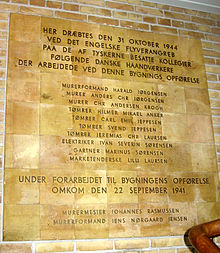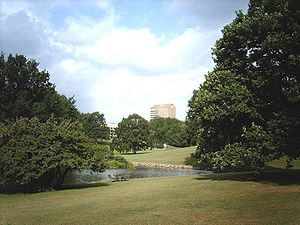| Aarhus University | |
|---|---|
| Aarhus Universitet | |
 | |
| Latin: Universitas Aarhusiensis | |
| Motto | Solidum petit in profundis (Latin) |
| Motto in English | Seek a firm footing in the depths |
| Established | 1928 |
| Type | Public university |
| Rector | Lauritz Broder Holm-Nielsen |
| Staff | 10,152 (Academic 5,829) (Technical and administrative 4,323) |
| Students | 37,047 |
| Doctoral students | 740 |
| Location | Århus, |
| Affiliations | EUA |
| Website | www.au.dk |
Aarhus University (in Danish, Aarhus Universitet), located in the city of Århus, Denmark, is Denmark's second oldest and second largest university (after the University of Copenhagen).
The university was founded in 1928 and has an annual enrollment of more than 37,000 students.
Aarhus University housed Denmark's first professor of sociology (Theodor Geiger, from 1938–1952) and in 1997 professor Jens Christian Skou received the Nobel Prize for Chemistry for his discovery of the sodium-potassium pump.
History
Aarhus University was founded on 11 September 1928 as Universitetsundervisningen i Jylland ("University Teaching in Jutland") with an enrollment of 64 students. Classrooms were rented from the Technical College and the teaching corps consisted of one professor of philosophy and four associate professors of Danish, English, German and French. Until then the University of Copenhagen was the only university in Denmark. In 1934 the faculty of humanities got state accreditation, state funding and the right to conduct exams. Until that time students had to go to Copenhagen to complete their studies. In 1936 a faculty of economics and law was created, in 1942 the faculty of divinity was created and the faculty of science was created in 1954.
The use of the name Aarhus Universitet began in 1933. Even though the name of the city, Århus, has been spelled with Å since the reform of Danish orthography in 1948, the name of the university insists on the old spelling with Aa. The official English translation of the name is Aarhus University (formerly, The University of Aarhus).
The entire campus was designed by the late C.F. Møller, whose firm, C.F. Møller Architects, has remained in charge of its further development, including its most recent additions: five new auditoria, completed in 2001.
British air strike during World War II

During the German occupation of Denmark in the Second World War the Gestapo had set up its regional headquarters in two dormitories on the campus. At request of the Danish resistance movement the Royal Air Force bombarded the campus on October 31st 1944, completely leveling the two dormitories to the ground. However one of the aircraft was hit by German guns and was forced to drop its bombs on the main building. The architect C. F. Møller was present in the main building during the air strike but survived and was later dug free from the rubble. However ten workers were killed during the bombardment.
It is said that the first thing C. F. Møller asked after his rescue was if "the arches had been destroyed", referring to the masonry arches decorating the main building. He knew that if they had been destroyed there would not have been money for reconstruction. However the arches were not damaged and survive to this day.
The airstrike on the University of Aarhus took place in a heavily populated area and the campus was surrounded by two hospitals. To avoid civilian casualties the air strike only took place after several months of intense training on a model of the campus.
Organization and administration
The university is governed by a board consisting of 13 members: 8 members recruited outside the university form the majority of the board, 2 members are appointed by the scientific staff, 1 member is appointed by the administrative staff, and 2 members are appointed by the university students. The Rector is appointed by the university board. The rector in turn appoints deans and deans appoint heads of departments. There is no faculty senate and faculty is not involved in the appointment of rector, deans, or department heads. Hence the university has no faculty governance.
Faculties
The university is organised in eight faculties:

- The Faculty of Humanities (Det Humanistiske Fakultet), which has offered courses since 1928.
- The Faculty of Health Sciences, consisting of the former Faculty of Medicine (which began courses in basic medical subjects in 1933) and the former Dental School (added to the Faculty of Medicine in 1992, when the name was changed to the Faculty of Health Sciences).
- The Faculty of Social Sciences, consisting of the former Faculty of Economics and Law (established in 1936) and of Political Science and Psychology.
- The Faculty of Theology, established in 1942. Courses in theology had been offered from 1932, being previously taught at the Faculty of Arts.
- The Faculty of Science, which was established in 1954 by moving Physics and Chemistry from the then Faculty of Medicine and Geography from the then Faculty of Arts. Mathematics was established as a new subject, followed by Biology and Geology.
- The Faculty of Agricultural Sciences, formerly Danmarks JordbrugsForskning (DJF), which was amalgamated with the university in 2007.
- Aarhus School of Business, which was founded in 1939 and amalgamated with the university in 2007.
- The National Environmental Research Institute (NERI), which was amalgamated with the university in 2007.
Enrollment

As of 2007, the number of students is c. 35,000. Each year more than 900 international exchange students come to Aarhus University to study for one or two semesters.
Student organizations
The largest student organizations at Aarhus University are the Student Union (Studenterrådet) and Studenterlauget. The Student Union represents the main student body at Aarhus University while Studenterlauget represents the students at Aarhus School of Business. Both the Student Union and Studenterlauget are represented on The University Board.The Student Union also arranges annual concerts and seminars, and publishes the student magazine Delfinen (The Dolphin).
There are political students organizations at the university, the largest of which include the Social-Democratic Students (Frit Forum), Conservative Students (Konservative Studenter), and Liberal Students (Liberale Studerende). The Conservative Students union publishes the student magazine Critique. The Liberal Students union publishes the leaflet Minerva.
Campus

The campus master plan competition was won in 1931 by the collaborative scheme of Danish architects, Kay Fisker, C.F. Møller, and Poul Stegmann with landscape architect C. Th. Sørensen. The design hosts a wide variety of buildings over a large space, but each building is composed of the same yellow brick and roofing tile, giving the whole campus a unified look. Construction commenced in 1932 and has continued into the 21st century. It was one of the first Danish, functionalist, public buildings and has been included in the Ministry of Culture's canon of Danish architecture. C.F. Møller and his company continued alone on the campus after 1942.
INANO
Interdisciplinary Nanoscience Center (founded in 2002 by Professor Flemming Besenbacher) provides educational programme in nanoscience consists of an interdisciplinary curriculum covering a broad spectrum of introductory, advanced, and specialized courses, which aim at providing the students with a sufficiently broad basis to conduct interdisciplinary research within nanoscience and at the same time achieve disciplinary depth and specialized skills in selected areas. Hence, the education encompasses physics, chemistry, biology, molecular biology, mathematics and computer science.
Ranking
The university is ranked 93 in the 2008 Shanghai Academic Ranking of World Universities among 17,000 universities in the world, and 63 in the world by THES- World University Ranking 2009.
| Ranking (year) | World Rank | European Rank |
|---|---|---|
| THE - QS World University Rankings (2008) | 63 | |
| Academic Ranking of World Universities (08/2008) | 93 | |
| Professional Ranking of World Universities (2007)[ | - | |
| THE - QS World University Rankings (2007) | 126 | |
| Web Ranking of European Universities (08/2008) | 134 | 30 |
The university is ranked number 63 in the 2009 THE–QS World University Rankings (known from 2010 onwards as the QS World University Rankings) and listed as number 2 of universities in nordic countries An overview of the last years:
| Year | Rank (Change) |
|---|---|
| 2005 | 138 |
| 2006 | 126 (▲ 12) |
| 2007 | 114 (▲ 12) |
| 2008 | 81 (▲ 33) |
| 2009 | 63 (▲ 18) |
Courses



Aarhus University has both undergraduate and postgraduate programmes in the following subjects:
- Aesthetic Subjects
- Biology
- Bosnian/Croatian/Serbian
- Chemistry
- Chinese
- Classical Archaeology
- Classical Philology
- Cognitive Semiotics (EliteUddannelse)
- Comparative Religion
- Computer Science
- Czech
- Dentistry
- Economics
- Ethnography
- European Studies
- Geology
- Greek
- History
- History of Ideas
- Hungarian
- Information Studies
- Japanese
- Latin
- Law
- Linguistics
- Management
- Mathematical Economics
- Mathematics
- Media Studies
- Medicine
- Medieval and Renaissance Archaeology
- Modern Languages
- Molecular Biology
- Nanotechnology
- Nordic Language and Literature
- Philosophy
- Physics and Astronomy
- Political Science
- Prehistoric Archaeology
- Psychology
- Russian
- Scandinavian Studies
- Semitic Philology
- Sports Science
- Statistics
- Theology
Cheminova controversy and academic freedom at AU
Aarhus University is the owner of the chemical manufacturer Cheminova, who controversially has been selling the methyl parathion pesticide to Brazil farmers.
In 2009, senior researcher Mette Jensen emailed her colleagues at AU, asking whether they thought Cheminova should stop selling the controversial pesticides. For this, the university threatened her with dismissal.
The university's Pro-Vice-Chancellor Søren E. Frandsen denies that the university had made any mistakes or threatened the freedom of speech and academic freedom of its staff.
Notable Alumni and Staff
- Aage Frandsen, Danish politician, Member of the Danish Parliament 1971-1975, 1987-1990 and 1994-2005.
- Anders Fogh Rasmussen, Prime Minister of Denmark from 2001 until 2009. Secretary General of NATO from August 2009.
- Bertel Haarder, Danish politician, Member of the Danish Parliament.
- Bjarne Stroustrup, Danish inventor, designer and original implementer of the C++ programming language.
- Bjørn Lomborg, Danish author, academic, and environmentalist.
- Crown Prince Frederik, Crown Prince of Denmark.
- Dan Jørgensen, Danish politician. Member of the European Parliament since 2004.
- David Gress, Danish-American historian.
- Helmuth Nyborg, Danish professor of developmental psychology.
- Jens Christian Skou, Danish chemist and Nobel Prize laureate in Chemistry 1997.
- Jens-Peter Bonde, Danish journalist, author, politician and Member of the European Parliament 1979-2008.
- John Frandsen, Danish composer, organist and conductor.
- Johannes Lebech, Danish politician.
- Johannes Sløk, Danish philosopher and theologian.
- Kjeld Philip, Danish economist and politician.
- Lene Espersen, Danish politician, Minister of Economic and Business Affairs, Deputy Prime Minister and chairman of Det Konservative Folkeparti since 2008.
- Lene Hau, Danish physicist.
- Naser Khader, Danish-Syrian politician and Member of the Danish Parliament. Chairman of the Liberal Alliance 2007-2009.
- Queen Margrethe II, Queen regnant of Denmark since 1972.
- Søren Gade, Danish politician, Minister of Defence and Member of the Danish Parliament.
- Svend Auken, Danish politician. Chairman of the Danish Social Democrats 1987-1992.
- Torben M. Andersen, professor, former Chairman of the Welfare Commission.
- Tøger Seidenfaden, Danish journalist. Since 1993 editor-in-chief at Politiken.
- Yildiz Akdogan, Danish politician, Member of the Danish Parliament since 2007.
Residence Halls
- Bronzealdervænget
- Børglum Kollegiet
- Dania kollegiet
- Grundtvigs Hus Kollegiet
- Hejredal Kollegiet
- Herredsvej
- Kirsebærhaven
- Kløvergården
- Kollegierne i Universitetsparken
- Ladegårdskollegiet
- Nørre Alle Kollegiet
- Ravnsbjerg Kollegiet
- Rundhøjkollegiet
- Skejbygårds Kollegiet
- Skejbyparken
- Skelager Kollegiet
- Skjoldhøj Kollegiet
- Skovkollegiet
- Stenaldervej Kollegiet
- Tandlægekollegiet
- Teknologkollegiet
- Vilhelm Kiers Kollegium
Kollegierne i Universitetsparken are located on campus; the other residence halls are spread all over the city.
Partner Universities
 University of Greifswald, Germany
University of Greifswald, Germany- member of the Coimbra Group,
- member of the Utrecht Network.







0 comments:
Post a Comment